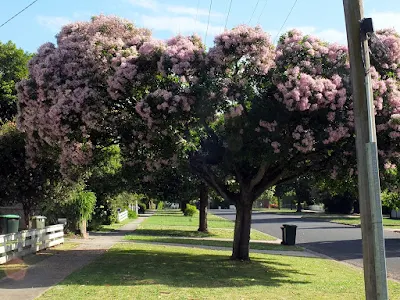Winter has gone – Drouin’s Cape Chestnuts are
telling us so.
The Cape Chestnut, Calodendrum capense, (the South African National BiodiversityInstitute), is not related to the chestnut tree family but is in fact a member
of the citrus family and the name says it all - ‘Calodendrum’ is Greek for
‘beautiful tree’.
Click on images for a larger view
In its countries of origin, Ethiopia,
Kenya, Uganda, Tanzania, Malawi, Zimbabwe and South Africa, the hard wood is
sometimes used for furniture making, flooring and tool handles.
The Cape Chestnut is a well shaped,
single-trunked tree with beautiful pink/white flowers covering the canopy making
it a popular ornamental street tree. The root system is not especially invasive
and the tree is capable of withstanding severe pruning it seems. The Cape
Chestnut is a great shade tree for combating the urban heat island effect, (a
previous blog post – The Urban Heat Island Effect).
The leaves contain numerous oil glands and
when crushed they give off a lemony-pine scent. In parts of South Africa today,
the oil is still extracted and used as an ingredient for several natural
ointments, medications and cosmetics.
The pink flowers of Drouin’s Cape Chestnuts
at present combine and contrast beautifully with the mauve/blue of the many
Jacarandas in flower at the moment, providing a visual feast for the eye.
The existence of Drouin’s Cape Chestnuts is
due entirely to Roy Everard Ross, the Buln Buln Shire Engineer and Building
Surveyor from 1925 to 1946, (an earlier blog post about Roy Everard Ross – TheEngineer Who Loved Trees).
Princes Way near the library and Hearn St
are perhaps the best places to see some examples of this beautiful street tree.
By all accounts, the Cape Chestnut is
easily grown from seed and once struck is easy to transplant – now there’s an
idea!







I walked past Festival lane this morning and what a visual feast. The jacaranda there had dropped its purple flowers on the path like a royal carpet. You're right that the purple of the jacarandas and the pink of the Cape Chestnuts look marvellous together. Now we just need a Cape Chestnut in the centre of town!
ReplyDelete